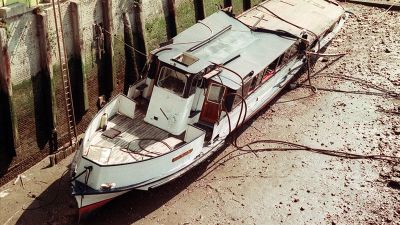Marchioness safety lessons still not learnt 30 years on from tragedy

The chances of an older vessel surviving a collision on the River Thames have not significantly improved since the Marchioness disaster in which 51 people died 30 years ago, the Port of London Authority (PLA) has warned.
The pleasure boat, Marchioness, was packed with partygoers when it collided with the dredger Bowbelle in central London in the early hours of August 20, 1989.
A series of safety improvements were implemented on the Thames after the tragedy, but little has been done to reduce the risk of older boats sinking after a crash, PLA chief executive Robin Mortimer said.
Budapest boat crash: Captain arrested as hunt for missing passengers continues
Owner of sightseeing boat in fatal crash near World Cup city ‘was intoxicated’
He said: “The concern we’ve got is that the impact side of the risk is still fairly similar for older vessels because the vessel itself hasn’t changed."
Flashing lights on bridges and a system for tracking river traffic are among steps taken to reduce crashes on the river since the disaster.
“If all of those measures don’t work effectively and there is a collision then the consequences could still be very serious,” Mr Mortimer said.
The PLA is responsible for overseeing navigational safety on the Thames.
Mr Mortimer is backing a proposal by the Maritime and Coastguard Agency to enforce safety recommendations made following the Marchioness tragedy, which could stop some older vessels from sailing on the Thames.
Following a public inquiry into the accident, Lord Justice Clarke published a report in 2001 stating that older boats should not have an open-ended exclusion from modern safety standards.
Modern vessels have several compartments below the water line to reduce the likelihood and speed of them sinking if they start to flood after an accident, but many older boats are not required to survive even minor damage.
Mr Mortimer accepted it is too expensive or impractical for some older vessels to be adapted to meet tougher regulations.
“It’s not us taking a position because we don’t like these boats,” he said. “It’s because there’s good data to show that incidents happen and there’s a big risk if one happened to an older vessel.”
Since January 2010, there have been 35 collisions on the Thames involving vessels built before 1992.
In 2008 a modern boat which suffered an eight-foot gash after crashing into Westminster Bridge stayed afloat as flooding was contained to a single compartment.
Mr Mortimer warned that if the incident featured an older vessel “it potentially would have sunk and there could have been a serious number of casualties”.
Most of those onboard the Marchioness were high flyers from the finance and fashion worlds.
The victims included Francesca Dallaglio, 19, the sister of former England rugby captain Lawrence Dallaglio.
Those who lost their lives will be remembered in a vigil on Monday night.
A procession will leave Southwark Cathedral and make its way to Bankside, close to the accident site.
Survivors and families of the victims will speak at a short service led by the Bishop of Southwark.
Attendees are invited to bring natural petals to throw into the water and carry a candle in a jar.
Pleasure boats and vessels belonging to the police, fire and rescue, the Royal National Lifeboat Institute and the PLA will gather on the river.